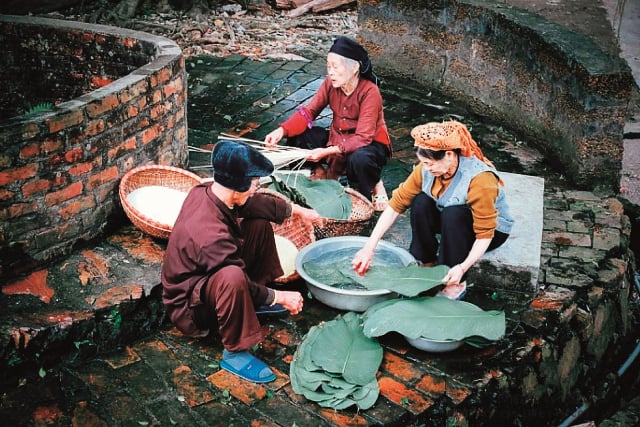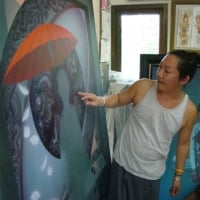*The article is a memoir by author Le Hong Lam, about the Tet holidays in his childhood memories in the Northern countryside.
Now every year when I return to my hometown to celebrate Tet with my parents, on the first morning of the holiday, when I wake up, I still vividly remember the sounds of people talking under the flickering firelight, the smell of new rice porridge mixed with the smell of incense sticks floating in the early morning smoke, the sound of pigs squealing in the lingering mist of the late morning of the old year, then the sound of chopping, the sound of pounding meat, the radio playing a lively Spring song... All those sounds and flavors mixed together, creating a ghostly atmosphere imbued with the warmth, love, peace, and nostalgia that is unforgettable for those who were "born in the village".
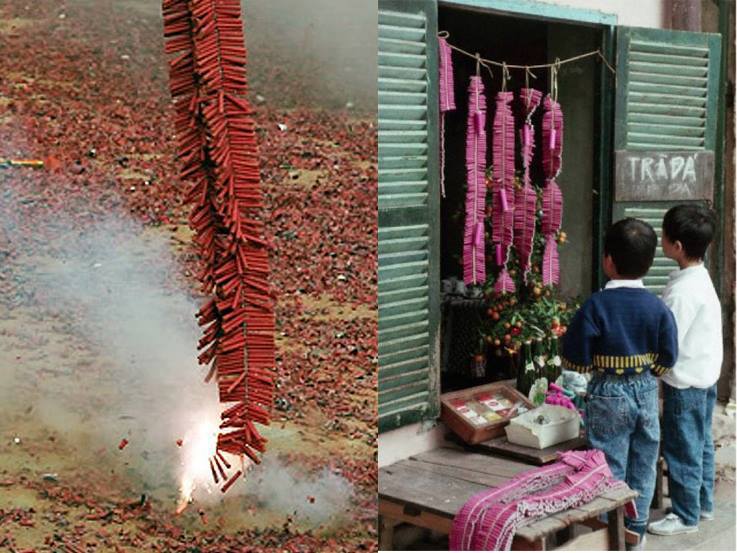
Talking about the old Tet, two things are indispensable: incense and firecrackers.
When talking about the old Tet, two things are indispensable: incense and firecrackers. My house was near the Rang Hac mountain range that has been mentioned in poetry. Every time Tet was near, groups of children would carry hoes up the mountainside to find “incense trees” (now I can’t remember what kind of tree it was), dig up the trunk and roots, bring them home to cut into small pieces, dry them, grind them, and find a thin piece of cellophane paper. If not, they would take student notebooks, peel them in half, spread this incense powder so that it fits an incense stick, place a stick made of young bamboo, thinly sliced (to burn easily), wrap it around, and at the end of the stick, the “incense” was glued with… a few grains of sticky rice to make it stick, and that was an incense stick. When lit, the scent of herbs, the smell of the countryside, the strong and elegant smell of the mountains and forests lingers in my mind until now.
There are many types of firecrackers: small firecrackers (as small as a ditch shrimp), big firecrackers (as big as a fruit knife handle now) and mortar firecrackers. Small firecrackers are difficult to make by yourself so they are usually bought at the Cooperative Store. We children take them apart and light them crackling from the 24th to the 25th of December. Big firecrackers have a head fuse (one end is sealed, the other end is placed with the firecracker fuse and then covered), and a middle fuse (both ends are covered, a hole is drilled in the middle to insert the firecracker fuse and then covered). The head fuse type is usually the Binh Da style firecracker in the North, the whole long string of firecrackers is neat, each one has a line. The middle fuse firecracker is usually the Da Nang style firecracker, it explodes loudly, the paper is torn into small pieces and looks very pleasing to the eye but the whole string of firecrackers looks messy and messy, very difficult to pack into a bundle, very difficult to weave a whole cake because the middle fuse often falls out.
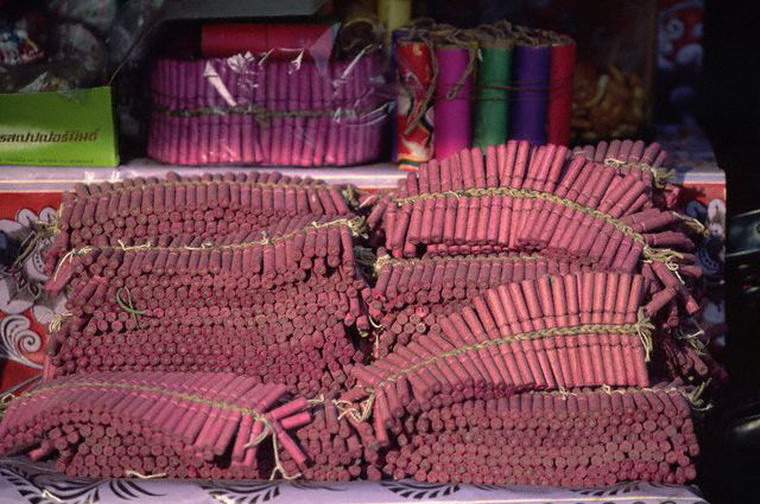
Firecrackers are difficult to make yourself so they are usually bought at Cooperative Stores.
The mortar is usually the firework that ends the firework series, the size is as big as a wrist, some fancy houses roll it as big as a calf, even as big as a thermos. It starts to crackle and then booms for a long time, until a loud, deep "boom" is heard, that's when the children rush in to pick up the discarded firework.
Usually, during Tet or weddings, firecrackers are set off in full bands, otherwise, they are just one at a time. The worst part is for the women, who are busy cutting meat, picking vegetables, cutting ham, and wrapping cakes, and their excited children or younger siblings take a firecracker out into the yard and light it up with a bang, startling them and sometimes knocking over a pot of braised fish. It is only then that they are angry, but when the whole country stops setting off firecrackers, women are the ones who miss the old Tet firecrackers the most, with the most longing and nostalgia. Like my mother, every time Tet comes, she feels absent-minded: only when there is the sound of firecrackers does Tet begin, does she feel that New Year's Eve is near...

Every Tet holiday, mothers are busy with work.
Since we only had one son, my father spoiled me. For many years, my eldest sister spent a day taking me to the "main road" (my hometown's district town) to buy enough firecrackers for me. The number of firecrackers was bought to ensure enough: one to be burned when welcoming Mr. Vai (burning incense to worship the New Year's Eve on the afternoon of the 30th - officially the arrival of Tet), one to be burned at New Year's Eve, usually the best, longest, most expensive, the sound had to be sharp, the firecrackers had to be torn all over; if the firecrackers failed or failed to tear the paper, my mother would complain, fearing that the new year would be "stormy". One to be burned on the morning of the first day of the New Year when my father had just lit the New Year's offerings and one to be burned when burning votive papers (sending the ancestors back to their "homes" after Tet). There were usually four firecrackers in total, but one or two more had to be bought, just in case our New Year's Eve firecrackers had finished burning but the neighbors were still doing great, so we could compete again. I remember one year there was a very famous house. New Year's Eve was over, everyone was happily listening to the President's New Year's greetings and giving lucky money to each other, when suddenly we heard the sound of firecrackers somewhere starting to go off, each one making a loud, clear, slow, and very majestic sound.
My father was the Principal of the commune's primary and secondary school, but according to the regulations at that time: children follow their mothers, so when it came time to distribute Tet gifts according to the standard, the female teachers under his authority received large and small packages, while my father received almost nothing. Perhaps due to the standards of the leaders, it was not until the afternoon of the 30th of Tet that I saw him bring home a box of Kim Anh dry tea (I still remember the words "strong taste, green water" painted on the tin box) and a few packages of sesame candy. At that time, service providers had started to practice English, so children whose parents were teachers kept asking each other if their family had Sesame candy to eat. Peach trees for Tet were usually the faded peach branches that my father cut down and brought back from the school garden. Some years they were as dry as firewood, some years they were all leaves, rarely were there enough buds and beautiful flowers to show off their colors, but we children still puffed up balloons to hang them up, making them very cheerful and radiant.
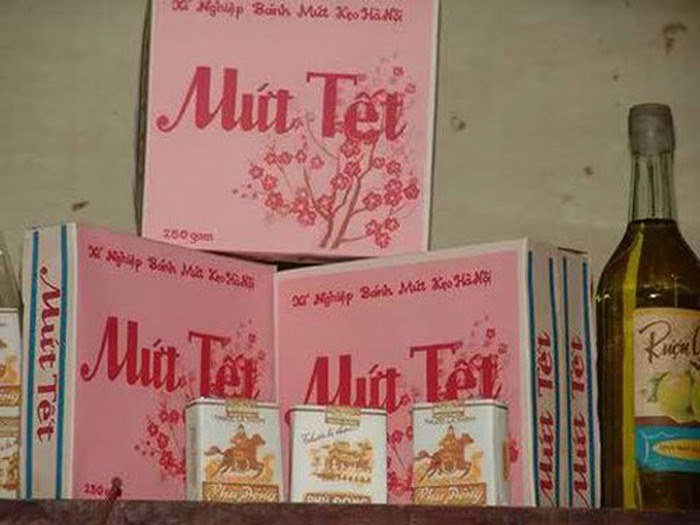
In the past, cakes, candies and jams were still a great happiness every Tet holiday.
Near Tet, if the District Education Office could get permission to transport a few bags of sugar to the teachers to share during Tet, it would be so much fun. The Storekeeper who is also an Accountant would show them how to transport the sugar to my house and divide it there. The owner of the house was also the Principal's house, so they would get a few extra ounces. My sisters and I grew up following the color of the sugar our father was given: when we were young, it was jet black sugar mixed with bits of sugarcane pulp (this type of sugar is only used to cook sweet soup), then yellow, and finally ivory white.
Now life is much more abundant. Going to the market for a while, you can find everything, every day can be Tet, so the old Tet flavor has faded a lot. For me, those are the traditional Tet cakes that have gradually disappeared: Banh Quat (made from sticky rice flour mixed with a little turmeric powder, spread out like a paper fan and then dropped into a pan of boiling lard), Banh Gai (similar to a Hai Duong specialty, made from sticky rice flour mixed with gai leaves), Banh Mat, Che Lam, Banh Day, perhaps only Banh Chung is indispensable. I remember, every year near Tet, my sisters and I asked my mother to make this cake or that cake, she frowned, and gently scolded: This year I am too busy to make it. But then after Tet Tao Quan, I saw my mother preparing to make it, and there were again the evenings of excitedly gathering around to wipe leaves, making and wrapping cakes, happily and passionately. The children of the past wore dirty old clothes but their faces were rosy and their eyes sparkled as they sat by the crackling fire happily boiling banh chung on the days before Tet. They looked so happy.
Another Tet is coming, eagerly waiting for the day to drive back to my parents, back to my hometown and return to the old Tets, as we often say to each other: only when we have a hometown can we have a complete and full Tet.
